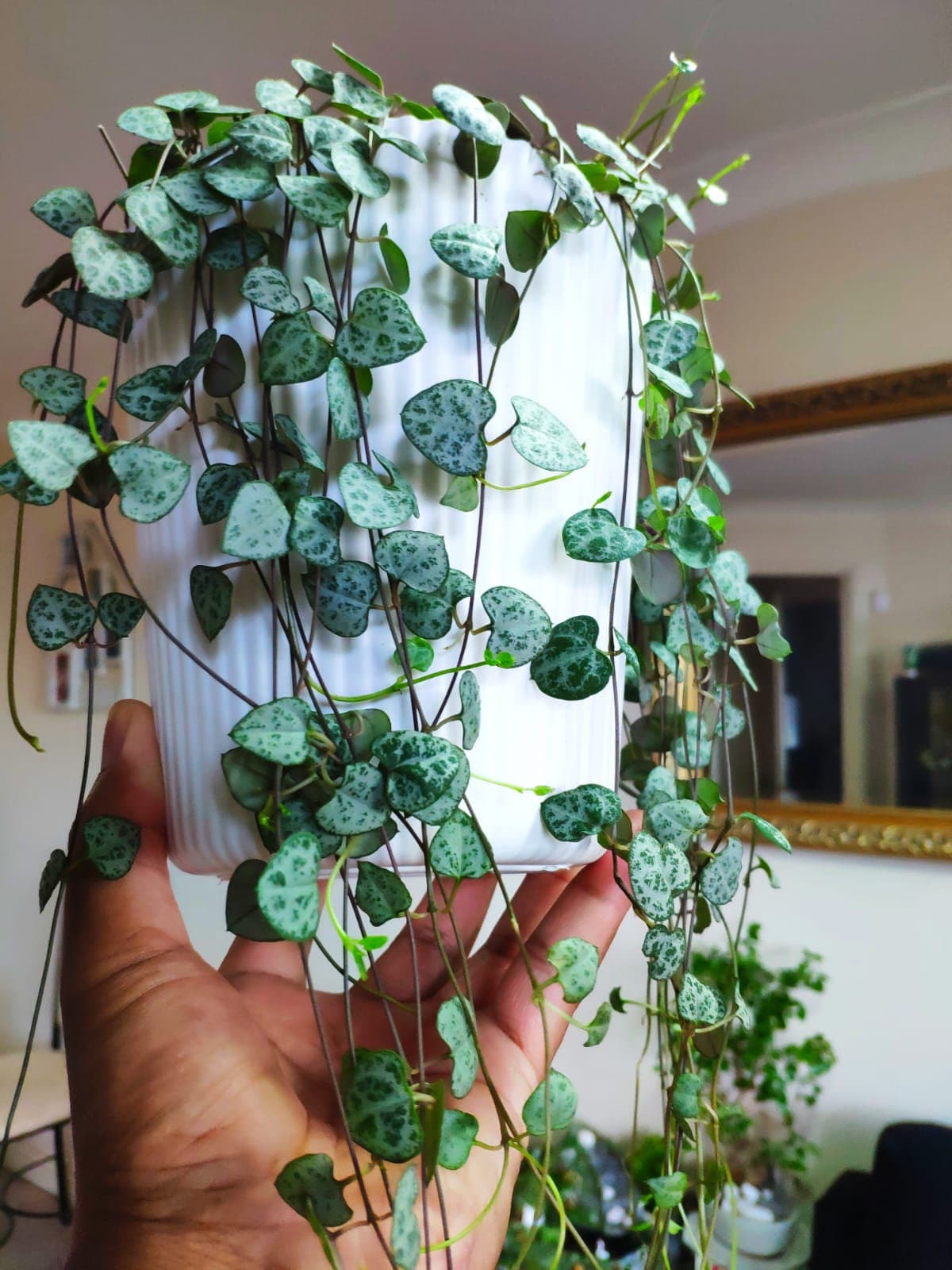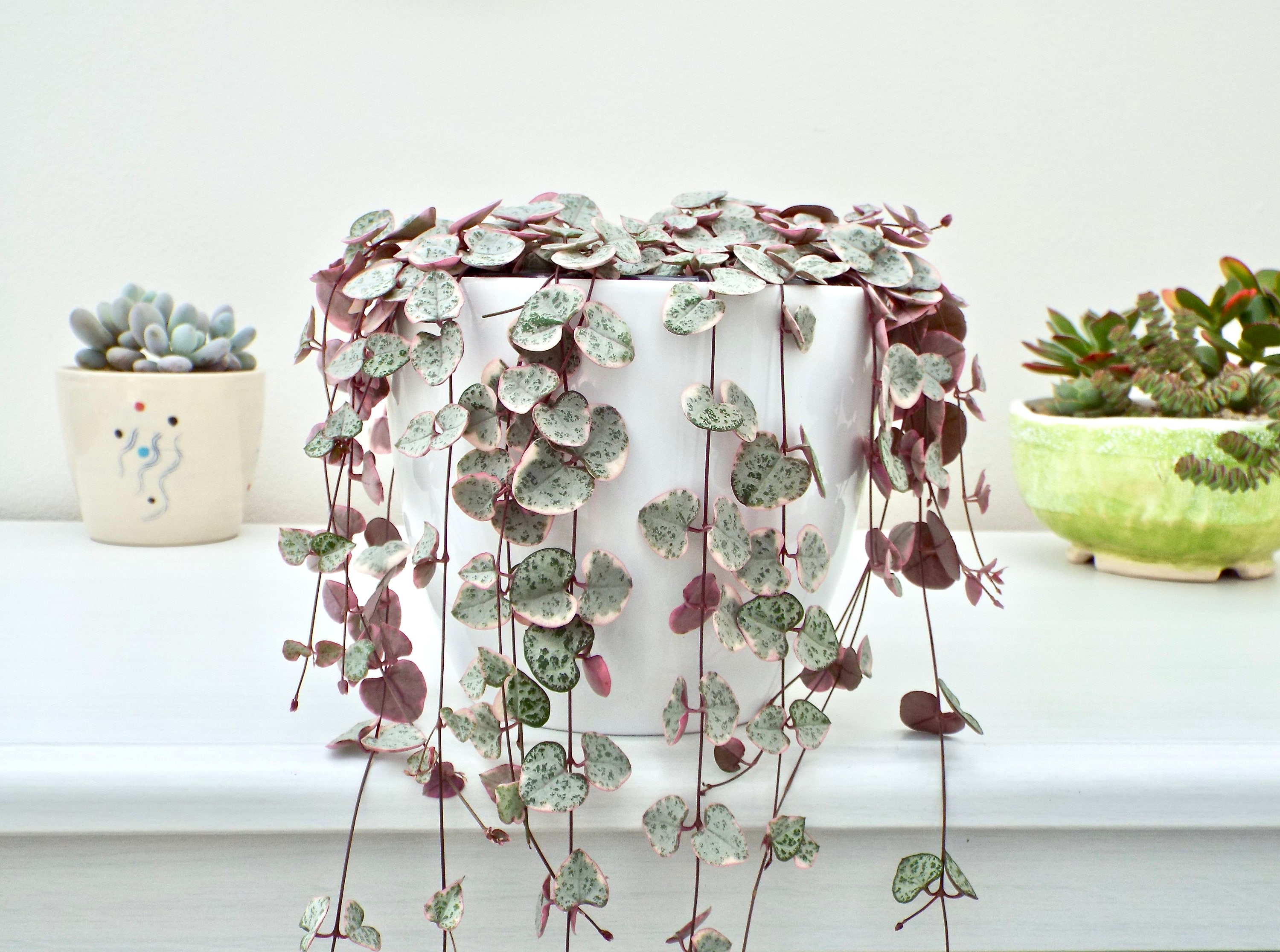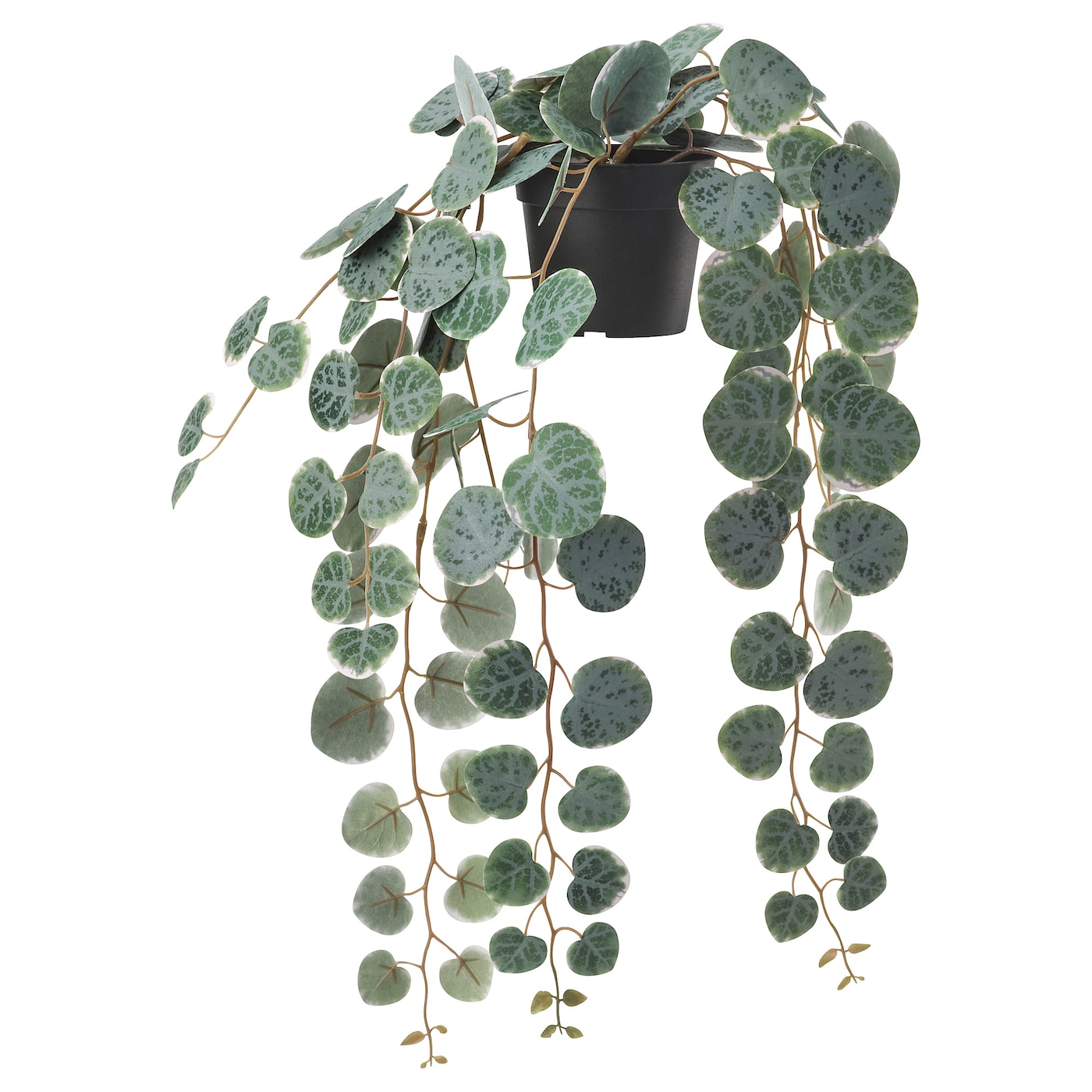If you’re curious about several ways to multiply String of Hearts, keep reading. But first, know that this plant is a succulent with long stems that trail to the ground. It looks more appealing because of the heart-shaped leaves. Chain of hearts, sweetheart vine, hearts intertwined, collar of hearts, and rosasy vine are a few common names for this indoor vine. As you may know, these names all contain the word “vine” because they are vine-based trailing indoor plants. Ceropegia woodii, the botanical name of this plant, is an easy-to-propagate member of the Apocynaceae family. It has a height of 10 cm and can grow up to three to four meters, sometimes even more. Let’s learn about the different methods for propagating this plant, such as the butterfly method and the string of hearts method.
Table of Contents
How to Propagate String of Hearts
String of hearts can be multiplied by stem cutting, tubers (root balls), nodes, or by soaking seeds in the ground before planting. String of heart plant propagation via the butterfly method, in which the node of the string of heart stem may develop new roots. The stem cutting technique has replaced the traditional technique for extracting easy-to-propagate roots or tubers. Many people I spoke to successfully propagated their plants utilizing the butterfly or node cutting methods.
6 Simple Ways to Spread a String of Hearts
1 . By Stem Cutting (Basic)
The stem cutting technique is the simplest method for propagating houseplants, and it is frequently used. Water propagation is my preferred method over soil mix propagation because the roots grow more quickly in water than in soil.
To ensure that roots grow effectively, soil should be a well-drained, lightly constructed mixture that can both supply enough water and drain it quickly.
Take 3–4 inches of stem for the cutting length and put them in potting soil or a small pot. In terms of the environment, you should hang a string of hearts where there is some indirect light or where there is no direct sunlight.
Many individuals utilize rooting hormone in power form and inject it into the base or lower final node of the stem for FAST PROPAGATION. They then plant the plant in a soil mixture.
Once a week or every six days is sufficient for watering. Always check to see if the potting mix is losing water before moistening it with a water spray. This cutting requires moisture to start growing, and if there is not enough water, it won’t sprout.
I advise taking 2-3 cuttings, nurturing them, and lowering the possibility of propagation failure. Despite the fact that they can and won’t simply die, they will grow roots with ease.
The optimal time to try the rooting approach is in the spring.
2 . By Stem Cutting in Water
Growing string of hearts in water is a great technique that is also user-friendly for beginners (as they can try). Just snip a few healthy, disease-free branches from your existing plant.
Cuttings should be 2.5, 3, or 4 inches long, and I advocate using sterilized pruners since occasionally we use old pruners that have germs that attack the plant and ruin it.
So it is advised to use a cleaning pruner or any other type of cutting instrument, and to wipe the sharp object there with rubbing alcohol.
Additionally, if there is a leaf at the base of the stem cutting that is about an inch deep, a portion of the cutting will be submerged in water. Keep in mind that not all of the leaves at the stem’s base need to be removed.
If you’re unaware, I’ll tell you that new rooting can be seen at certain nodes in the stem. Additionally, leaves are produced at the stem’s node. Therefore, having nodes in the water is advantageous since it will speed up rooting. at the very least, submerge one node. for which the lowest inch of the cut was made with nodes.
Change the water every three days to keep it fresh and allow the plant to utilize the minerals in the water.
One stem cutting is not sufficient; at least 2-3 stem cuttings must be used in water to increase the likelihood of successful water-based growth.
I borrowed this plant from my neighbor, who is friendly and with whom I exchanged a special plant cutting that may produce three or four additional plants.
Put your cutting into the clear glass of the water jug or glass and set it in a location with indirect light. Additionally, keep changing the water every three days. It will take a few weeks for new roots to develop, so patience is required.
It’s time to plant your stem cutting in potting soil once it has developed some roots. In a string of heart cuttings, use quality soil.
Additionally, if you want to read a complete care guide for ceropegia woodii, check out the post where I’ve covered a number of important considerations for growing this succulent. Some of the best advice I provided is in that article.
3 . By String of hearts Tuber
String of heart tubers are widespread because they start to grow once a plant reaches a certain age and has been in existence for a while. You have undoubtedly seen potatoes, which are also tubers capable of producing roots and a complete plant.
Just keep in mind that a plant will essentially start out by forming some roots before starting to sprout shoots. Since this succulent is a vine-based plant, it will develop stems, and those stems will then result in the same tubers.
In order to PROPAGATE Ceropegia woodii, we won’t really cut the tuber; instead, we’ll use the vines bearing the tuber and bury it in the soil—either an inch or less of dirt above the tuber. Give it water on a regular basis and keep it moist so that it can begin to root.
When the tuber has enough roots, you can simply clip the stem from the main plant. Now take a new pot and some new potting soil and place your new string of hearts plant in it.
This plant may be multiplied utilizing the numerous tubers, and as you can see, propagation is fairly simple. Similar to how you might prepare many pots for each tuber and grow it, you could also share it with your neighbor or just sell it and get paid for your labor.
Don’t forget to set all of the tuber pots in partial sunshine as well, which will help them grow beautifully without damaging their heart-shaped leaves.
Also keep in mind that excessive watering might cause numerous other problems with the leaves.
4 . By String of hearts Seeds
The sole procedure in the string of hearts that Lotusmagus.com has covered is seed germination. Fresh seeds with white feathers attached will emerge as this plant reaches maturity. Just remove them.
When I was a child, I remember seeing these white, fluffy feathers fluttering around in my garden, and at the time, I had no idea what they were. Did you know that when these feather seeds fly and accidentally land on soil in various locations, they immediately sprout and flourish successfully?
Now all that’s left to do is germinate seeds by placing them in succulent and cactus potting soil and covering the top of the pot with plastic to keep moisture in. You will see that they have successfully sprouted in a few days.
I also suggest that folks take three to four seeds, so that if one doesn’t work, the other seeds still have a chance to work. Moreover, since it will start with seeds, this procedure will probably take some time. Tuber or stem cutting, which are the best methods of propagation in the string of hearts, should be used if you want to save time.
Want to learn more about the seeds pots on the heart string?
5. String of hearts butterfly method
Using the “string of hearts” butterfly method, cuttings are made into butterflies with the tops remaining as leaves and the bottoms remaining as cuttings in moss, perlite, or soil.
Butterfly technique steps:
- Take a stem cutting, or several stem cuttings, first.
- Cuttings should be made just above and below a pair of heart-shaped leaves that are 1 inch apart. The butterfly method is so named because you can discover the butterfly’s appearance with it.
- These cuttings are now placed in moss or perlite; however, the soil must be completely moist for the cuttings to grow in it.
- If you used perlite or moss, splash some water on it and give it a good soak.
- Your cutting should now be placed on top of the perlite or moss soil material. The top should be covered in leaves, and the stem cut is where the roots will eventually grow.
- In order to prevent your leaves from rotting in dry moss or perlite, apply a dry layer of 0.5 inch moss or perlite as well.
- Once it’s in position, it can resemble a butterfly.
- It’s a straightforward but perplexing approach. One thing to keep in mind is that you can grow this in the plastic container the moss or perlite came in. Yes, you placed cuttings on the top layer of the perlite-filled plastic growing media. I’m done now.
Some folks who have room in the pot only need to circle some vines of string hearts before placing them in the pot.
It is not a typical technique because many people have discovered that vines can produce new roots if they grow lower and reach the soil of a surface covered in high-quality sand.
If given the right conditions to survive and flourish, these plants can even spread themselves throughout forests and along rivers.
6 . By Repoting Stems Back in Soil(Cuttings)
The procedure is the same as what I described earlier; we simply cut the plant, repot it in the same container, and bury the cut portion by covering it with a thin layer of dirt. In a few days, it will start to grow roots.
In addition, you need to provide them with a moist environment by periodically pouring water on them and placing them in a shaded area. Check out more information on the string of hearts.
How to propagate String of Hearts in water?
Let’s grow a row of hearts in the water. A pruner, a large jar of water, and attention every three days are all you need. Take a stem of string from a heart and cut off 4-5 inches of stem just below the node so that it may be immersed in the water. After finishing the propagation process, place the stem in water and take care of it until it begins to root.
It is relatively simple to grow strings of hearts in water, but once you get them in the stem, you must change the water every two to three days to prevent fungal infections that could cause root rot. Put the jar in a location with some light exposure. Once it develops roots, it will continue to grow on its own, at which point you can move the string of hearts into a dirt pot.
How to propagate String of Hearts in soil
- Cut the string of the heart stem that appears healthy with a pair of sharp pruners.
- In order to prevent bacteria from spreading to our fresh stem cuttings, you must first clean the pruner blade with rubbing alcohol.
- Take a cutting from a healthy stem slightly below the node.
- Now, using a fresh container and well-draining soil, fill it with the potting mix, create a hole in the center, insert the stem cutting, seal the hole, and pat the earth down so it lies flat.
- If your plant is very dry, water it every three days.
- Until it produces rooting, place it in a warmer location with indirect light or shade being best.
- You’ve successfully grown a string of hearts in dirt.
How to propagate string of hearts in sphagnum moss?
Sphagnum moss can be used to propagate a string of hearts, but you’ll also need perlite and regular garden soil. For your succulent, it would function like a potting mix, and your plant can grow in this way. Sphagnum moss is typically utilized to aerate the soil. It also has the advantages of warming the soil and helping to retain moisture.
Where to cut String of Hearts for propagation?
Since new roots will occur there, string of hearts for propagation can be broken off from the stem right below the node. Both methods of propagation—soil or water—will cause the node to produce roots. This is a component of a heart-shaped chain. If you’ve already grown a lot of these plants and have very long stems, you can multiply this plant several times.
How long does it take to propagate string of hearts?
Why should you propagate a string of hearts?
When asked why you should multiply a string of hearts, the most frequent response we get is that it will make the balcony where it is floating in a hanging basket more attractive. Additionally, duplicating the string of hearts would ensure that, in the event that the original succulent dies, you have at least one backup plant for the heartstrings plant.
When should you propagate a string of hearts?
Early spring is the optimum time to propagate a string of hearts because the cold is just about to end and the sprouting season is approaching, which will help the plants’ roots grow more swiftly.
What is the Advantage of propagating a string of hearts?
Since girls love planting more than boys do, you would be giving it to women you care about on their birthdays. Second, you may sell it to get some money or just arrange the strings in a garden to enhance the beauty of your balcony.
What is String of hearts Node?
cluster of hearts Node is a location where leaves and branches grow together. When a string of hearts is formed, the leaves grow there, but when the node is placed in soil, roots begin to grow. This is referred to as a node, and it is quite helpful in growing a line of heart plants.
These nodes are obviously viewed as forming new roots in water propagation, and from there a new shoot will form. It has the capacity to create an entirely new string of delicious hearts.



